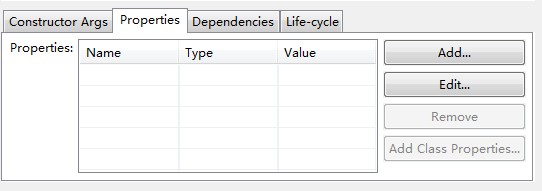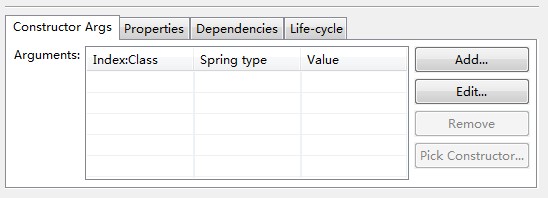spring核心:bean工厂的装配 3
2010-10-17 09:48
363 查看
本文中主要包含下面的几个内容:
7.何时使用singleton
8.设置bean的属性和协作者
9.bean构造函数选择决议
10.自动装配
11.依赖检查
7.何时使用singleton
如果bean使用的是singleton的话,那么通过getBean得到的始终是一个对象,如果使用的是prototype的话,那么每次spring会重新new一个新的对象。下面是测试的代码片段:
8.设置bean的属性和协作者
在spring中反转控制和依赖注入大致上通过两种方法实现:
1.通过set属性实现
2.通过类的构造函数实现
下面是一个简单的通过set属性实现的反转控制和依赖注入的demo:
SetterBean.java

通过这种方法生成的bean定义如下:
当然也可以这么写:
这里需要特别注意的是需要property的name属性需要和类中的set方法相对应。
2.通过构造函数实现反转控制和依赖注入简单demo:
ConstructorBean.java :

applicationContext.xml :
需要注意的是通过构造函数实现依赖注入和反转控制时,constructor-arg的顺序没有必要和类的构造函数的性质相一致。
9.bean构造函数选择决议
bean构造函数选择决议,及类似于函数重载时需要选择那个函数。
这里需要注意的是两个属性:
1.constructor-arg的type属性:默认的情况下,spring将<value>中的内容解析为string,所以在spring增加type属性,显示捆绑xxx类型。
2.constructor-arg的index属性:index属性用来索引各构造函数的参数的顺序,从0开始。
例如如果将修改成这样:
显然这是错的,于是产生如下的错误:
10.自动装配
自动装配通过autowire属性实现,主要是针对setter方式实现依赖注入和反转控制的bean:

这里有两个常见属性:byType,byName,其中byType的话,spring会自动查找和set中同类型的bean。同理byName,是通过和类文件中属性同名的bean相关联。
11.依赖检查
依赖检查确保所有的或者是部分的bean属性得到正确的设置。

其中object最常用,主要是对bean中被使用者进行检查。
7.何时使用singleton
8.设置bean的属性和协作者
9.bean构造函数选择决议
10.自动装配
11.依赖检查
7.何时使用singleton
如果bean使用的是singleton的话,那么通过getBean得到的始终是一个对象,如果使用的是prototype的话,那么每次spring会重新new一个新的对象。下面是测试的代码片段:
<bean id="singletoninstance" class="singletonornot.POJO" abstract="false" scope="singleton" lazy-init="default" autowire="default" > </bean> <bean id="prototypeinstance" class="singletonornot.POJO" abstract="false" scope="prototype" lazy-init="default" autowire="default" > </bean>
POJO p1 = (POJO)context.getBean("singletoninstance");
POJO p2 = (POJO)context.getBean("singletoninstance");
if (p1 == p2) {
System.out.println("p1 and p2 are the same");
}
POJO p3 = (POJO)context.getBean("prototypeinstance");
POJO p4 = (POJO)context.getBean("prototypeinstance");
if (p3 == p4) {
System.out.println("p1 and p2 are the same");
}8.设置bean的属性和协作者
在spring中反转控制和依赖注入大致上通过两种方法实现:
1.通过set属性实现
2.通过类的构造函数实现
下面是一个简单的通过set属性实现的反转控制和依赖注入的demo:
SetterBean.java
/**
*
*/
package beanfactory.coredi;
/**
* @author jefferyxu
*
*/
public class SetterBean {
private AnotherBean beanOne;
private YetAnotherBean beanTwo;
private int i;
public void setIntegerProperty(int i) {
this.i = i;
}
/**
* @return the beanOne
*/
public AnotherBean getBeanOne() {
return beanOne;
}
/**
* @param beanOne the beanOne to set
*/
public void setBeanOne(AnotherBean beanOne) {
this.beanOne = beanOne;
}
/**
* @return the beanTwo
*/
public YetAnotherBean getBeanTwo() {
return beanTwo;
}
/**
* @param beanTwo the beanTwo to set
*/
public void setBeanTwo(YetAnotherBean beanTwo) {
this.beanTwo = beanTwo;
}
public String toString() {
return "bean one :" + this.beanOne + " bean tow " + this.beanTwo +
" integer property " + this.i;
}
}
通过这种方法生成的bean定义如下:
<bean id="setterBean" class="beanfactory.coredi.SetterBean" abstract="false" lazy-init="default" autowire="default" p:beanOne-ref="anotherBean" p:beanTwo-ref="yetAnotherBean" p:integerProperty="1"> </bean>
当然也可以这么写:
<bean id="setterBean" class="beanfactory.coredi.SetterBean"> <property name="beanOne"> <ref bean="anotherBean"/> </property> <property name="beanTwo"> <ref bean="yetAnotherBean"/> </property> <!-- 注意这里填写的name属性需要和setterBean类中set 方法相对应,这里写的是integerProperty,所以 需要 存在setIntegerProperty方法 --> <property name="integerProperty"> <value>1</value> </property> </bean>
这里需要特别注意的是需要property的name属性需要和类中的set方法相对应。
2.通过构造函数实现反转控制和依赖注入简单demo:
ConstructorBean.java :
/**
*
*/
package beanfactory.coredi;
/**
* @author jefferyxu
*
*/
public class ConstructorBean {
private AnotherBean beanOne;
private YetAnotherBean beanTwo;
private int i;
public ConstructorBean(AnotherBean one,
YetAnotherBean two,
int i) {
this.beanOne = one;
this.beanTwo = two;
this.i = i;
}
public String toString(){
return "bean one :" + this.beanOne + " bean tow " + this.beanTwo +
" integer property " + this.i;
}
}
applicationContext.xml :
<bean id="contructorBean" class="beanfactory.coredi.ConstructorBean"> <!-- 注意这里参数的顺序没有必要 按照构造函数中的顺序 --> <constructor-arg> <ref bean="yetAnotherBean"/> </constructor-arg> <constructor-arg> <ref bean="anotherBean"/> </constructor-arg> <constructor-arg> <value>1</value> </constructor-arg> </bean>
需要注意的是通过构造函数实现依赖注入和反转控制时,constructor-arg的顺序没有必要和类的构造函数的性质相一致。
9.bean构造函数选择决议
bean构造函数选择决议,及类似于函数重载时需要选择那个函数。
这里需要注意的是两个属性:
1.constructor-arg的type属性:默认的情况下,spring将<value>中的内容解析为string,所以在spring增加type属性,显示捆绑xxx类型。
2.constructor-arg的index属性:index属性用来索引各构造函数的参数的顺序,从0开始。
例如如果将修改成这样:
<constructor-arg index="0"> <value>1</value> </constructor-arg>
显然这是错的,于是产生如下的错误:
Unsatisfied dependency expressed through constructor argument with index 0 of type
10.自动装配
自动装配通过autowire属性实现,主要是针对setter方式实现依赖注入和反转控制的bean:

这里有两个常见属性:byType,byName,其中byType的话,spring会自动查找和set中同类型的bean。同理byName,是通过和类文件中属性同名的bean相关联。
11.依赖检查
依赖检查确保所有的或者是部分的bean属性得到正确的设置。

其中object最常用,主要是对bean中被使用者进行检查。
相关文章推荐
- spring核心:bean工厂的装配 3
- spring核心:bean工厂的装配 4
- spring核心:bean工厂的装配 4
- spring核心:bean工厂的装配 5
- spring核心:bean工厂的装配 1
- spring核心:bean工厂的装配 5
- spring核心:bean工厂的装配 1
- spring核心:bean工厂的装配 6
- spring核心:bean工厂的装配 2
- spring核心:bean工厂的装配 6
- Spring核心Bean工厂装配__Spring学习笔记
- spring核心:bean工厂的装配 2
- Spring核心Bean工厂装配__Spring学习笔记
- Spring-装配Bean的3种方式-工厂静态方法方式配置Bean
- Spring-装配Bean的3种方式-实现工厂方法方式装配Bean
- 【Spring 核心】装配bean(二) JavaConfig装配
- 【Spring 核心】装配bean(三)XML配置
- Spring--IoC--Bean的装配--静态工厂Bean
- 【Spring 核心】装配Bean(一) 自动化装配
- Spring--IoC--Bean的装配--工厂方法设计模式
